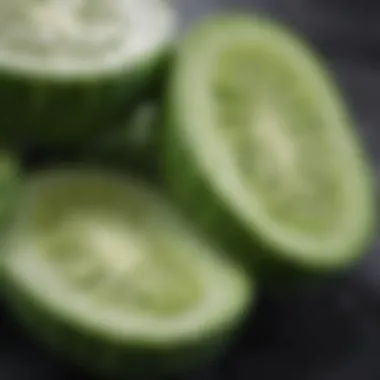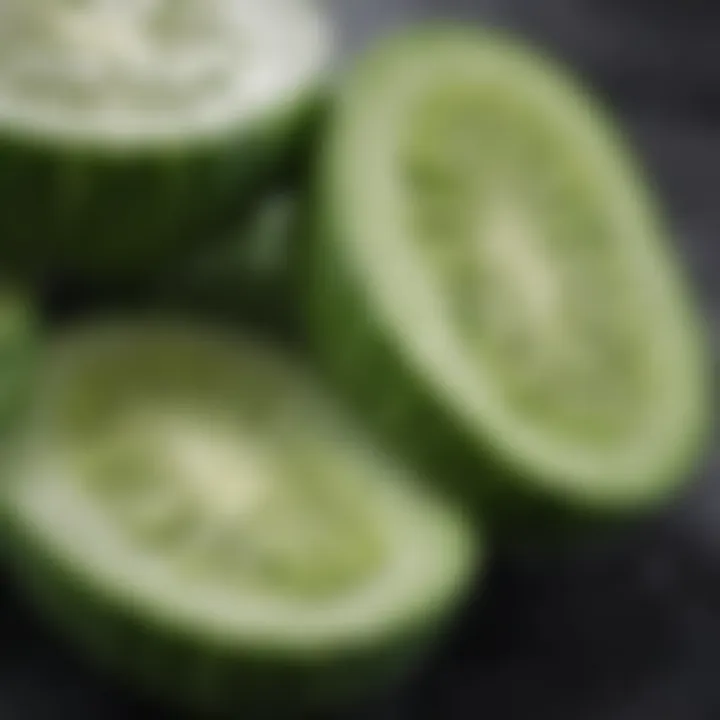Top Vegetables for Effective Belly Fat Reduction


Intro
In today's world, where health and wellness are hot topics, the idea of reducing belly fat often comes up. It’s no secret that our diets play a significant role in how we feel, look, and even perform. One area that has garnered attention is the consumption of certain vegetables. Not only are these vibrant foods packed with essential nutrients, but they can also aid in shedding unwanted belly fat.
With an avalanche of information available on weight loss, pinpointing effective strategies can feel like searching for a needle in a haystack. By focusing on specific vegetables, we can simplify the process of weight management and enhance our overall health.
Let's explore how integrating a variety of vegetables into your daily meals can make a difference, supporting not just a slimmer waistline, but a more balanced diet as well.
Wellness
Physical Health
Vegetables are the unsung heroes when it comes to physical health. They are low in calories yet high in fiber, which keeps you fuller for longer. Foods like broccoli, spinach, and cauliflower are particularly effective. These vegetables do an excellent job of promoting digestion and maintaining a healthy gut, which is essential for effective weight management. More so, the high vitamin C content in vegetables such as bell peppers can boost your metabolism, helping your body to burn calories more efficiently.
"Vegetables don't just fill your plate; they fill your life with vitality."
Mental Health
The connection between diet and mental well-being is profound. A balanced diet rich in vegetables can help maintain a steady mood and reduce feelings of anxiety. For instance, incorporating leafy greens into your meals provides essential nutrients like magnesium that support brain health. The act of cooking and enjoying fresh vegetables can also serve as a meditative practice, promoting mindfulness and a sense of accomplishment.
Nutrition and Diet
A well-rounded diet is crucial for maintaining a healthy weight. Vegetables are a cornerstone of nutritional guidelines. They provide a mix of vitamins, minerals, and antioxidants, all of which contribute to overall health. Crafting meals around a base of zucchini, carrots, or cucumbers, for example, can enhance satiety while allowing some room for other foods without going overboard on calories.
Fitness and Exercise
In the realm of fitness, vegetables can play a role in performance and recovery. Amino acids found in peas and asparagus support muscle repair, while the hydration from cucumbers can optimize your post-workout recovery. Including these types of vegetables in a pre-workout meal can invigorate your energy levels, leading to a more effective exercise session.
Lifestyle
Self-Care Practices
Incorporating more vegetables into your lifestyle can also be a form of self-care. Preparing fresh salads or stir-frying a mix of seasonal veggies not only nourishes your body but also allows for creative expression in the kitchen. This practice can be cathartic, providing a break from day-to-day stresses.
Healthy Recipes
Creating effortless dishes is part of the allure of cooking with vegetables. Here’s a simple recipe that highlights the benefits of three key vegetables:
Vegetable Stir-Fry
- Ingredients:
- Instructions:
- 1 cup broccoli florets
- 1 cup sliced bell peppers
- 1 cup snap peas
- Salt and pepper to taste
- Olive oil for sautéing
- Heat olive oil in a pan over medium heat.
- Add broccoli, sautéing for about 2 minutes.
- Add bell peppers and snap peas, cooking until slightly tender.
- Season with salt and pepper before serving.
Mindfulness and Meditation
Mindful eating, particularly through the lens of consuming vegetables, can enhance your overall awareness of food choices. By savoring the textures and flavors of vegetables, you develop a deeper connection to what you eat and, in consequence, how it affects your body and mind. This practice encourages a more intentional approach to nutrition and weight management.
Relationships and Social Interactions
Sharing meals can be a bonding experience with family, friends, or colleagues. Engaging in cooking sessions or potlucks that revolve around healthy veggie dishes can foster stronger social connections. Instead of opting for high-calorie options, introducing fun vegetable-centric dishes can set a positive tone for any gathering.
Tools for Living Better
Health Tips
To harness the benefits of vegetables effectively:
- Aim for a colorful plate with a variety of vegetables.
- Prepare meals in bulk to ensure you have healthy options available.
- Keep a stash of frozen veggies for convenience.
Quick Recipes
Some quick ways to include more vegetables include:
- Smoothies with spinach or kale.
- Wraps filled with assorted sliced veggies.
- Snack plates featuring carrots and hummus.
Stress Management Techniques
Incorporating vegetables into your diet can serve as a positive coping mechanism for managing stress. Preparing, cooking, and enjoying these nourishing foods distracts the mind from stressors, providing a therapeutic outlet.
Incorporating the right vegetables into your meals isn't just beneficial for reducing belly fat; it's a comprehensive approach to enhancing your health and well-being overall. As we continue through this article, we'll delve deeper into how specific veggies can help support this journey, making it relevant and accessible for everyone.
Understanding Belly Fat and Its Implications
Belly fat is not just an aesthetic concern; it carries significant health implications that deserve careful consideration. Understanding the different types of fat found in our bodies helps in identifying how they affect our health. Visceral fat, which is the type that wraps around the organs in the abdomen, can pose serious health risks. Conversely, subcutaneous fat lies just below the skin and is generally less harmful.
The significance of distinguishing between these types rests in their different effects on health. Visceral fat is more metabolically active, releasing substances that can lead to inflammation and insulin resistance. This can pave the way for chronic conditions like diabetes and heart disease. On the other hand, while subcutaneous fat is not inherently bad, excessive amounts can still contribute to overall health risks.
Incorporating vegetables into one's diet becomes a crucial strategy for managing belly fat. These nutrient-dense foods not only assist in fat reduction but also provide essential vitamins and minerals that enhance overall health. Plant-based foods can be powerful allies in combatting excess body fat due to their low caloric density and high fiber content.
Outlining the benefits of managing belly fat, one can see how it leads to improved overall well-being. Here are a few compelling reasons to consider:


- Reduction in Health Risks: Lowering belly fat decreases the chances of developing conditions such as heart disease, hypertension, and type 2 diabetes.
- Enhanced Digestive Health: A diet high in vegetables boosts fiber intake, aiding digestion and contributing to long-term weight management.
- Improved Quality of Life: Feeling lighter can improve mobility and energy levels, enhancing everyday activities.
In summary, understanding belly fat and its implications is vital for making informed health decisions. By recognizing the distinction between visceral and subcutaneous fat, and appreciating the role of diet—especially vegetables—individuals can take practical steps toward a healthier lifestyle. This foundation sets the stage for exploring effective dietary strategies to reduce belly fat.
The Role of Diet in Belly Fat Reduction
Diet plays a crucial role in not just our overall health, but specifically in managing and reducing belly fat. When considering how to tackle unwanted weight around the midsection, it’s essential to understand that food can either be a friend or a foe in this journey. Incorporating the right vegetables into one’s diet can provide numerous benefits, supporting both metabolic health and weight management.
Healthy eating isn’t just about counting calories; it’s about the quality of the food we choose to consume. Selecting a diet rich in vegetables sets a strong foundation for reducing belly fat. Vegetables are often low in calories but high in nutrients, meaning that they can fill you up without weighing you down. This balance is pivotal because it helps create a caloric deficit, which is necessary for weight loss.
"You can’t out-exercise a poor diet. Make wise food choices to see the best results."
To achieve effective belly fat reduction, it’s not merely eliminating certain foods; instead, it’s equally about the inclusion of nutritious foods that promote satiety and discourage snacking on high-calorie items. So, let’s dig a bit deeper into how the macronutrients — namely carbohydrates, proteins, and fats — interact with our bodies in the context of reducing belly fat.
Macronutrients and Their Impact
Macronutrients are the building blocks of our diet, and each type plays a distinctive role in how our body functions. Balancing macronutrients can help in optimizing weight loss efforts, particularly when it comes to belly fat.
- Carbohydrates: While many often demonize carbs, they are essential for providing energy. It's crucial to focus on the quality of carbohydrates consumed, favoring those that are whole and unprocessed. For instance, pairing leafy greens with whole grains can create a satisfying meal that doesn’t leave you feeling deprived.
- Proteins: Eating an adequate amount of protein is important. Protein helps build muscle mass and can support metabolic rate. Including protein-rich vegetables such as edamame or peas alongside your meals can enhance feeling full longer, reducing cravings.
- Fats: Healthy fats are important players in digestion and nutrient absorption. Sources like avocados and nuts can create a satisfying experience that pushes one away from unhealthy snacking. Remember, moderation is key, as fats are calorie-dense.
Importance of Fiber in Weight Management
Fiber deserves its moment in the spotlight when discussing weight management. This nutrient not only aids in digestion but also plays a crucial role in feeling satiated. Consuming fiber-rich vegetables can keep hunger at bay for longer periods.
- Promotes Fullness: Veggies like broccoli and Brussels sprouts are examples of high-fiber foods that expand in your stomach, making you feel fuller without the excess calories.
- Regulates Blood Sugar: Fiber helps in maintaining steady blood sugar levels, reducing spikes and crashes that often lead to cravings for unhealthy foods. When blood sugar remains stable, it makes it far easier to stay on track with healthy eating choices.
- Supports Gut Health: A healthy gut microbiome can influence body weight and fat distribution. Fiber serves as a food source for beneficial gut bacteria, promoting their growth and, by extension, supporting metabolic health.
In summary, the role of diet in reducing belly fat cannot be overstated. By paying attention to macronutrient balance and fiber intake, individuals can effectively use their dietary choices to support their overall wellness goals. Incorporating those vegetables high in essential nutrients while being mindful of what we consume ensures a well-rounded approach to tackling belly fat.
Vegetables: Nutritional Powerhouses
When we think about weight loss, often we picture complex strategies or elaborate meal plans. However, one of the simplest yet most powerful tools at our disposal are vegetables. Their role in any weight management journey can’t be overstated. Vegetables are not just low in calories; they are also packed with essential nutrients that contribute to overall health and wellbeing. This makes them indispensable allies in a quest to trim belly fat.
An important aspect of vegetables is their high fiber content. Fiber is fabulous for the digestive system and helps keep us feeling fuller longer. This can prevent that nagging urge to snack between meals. Vegetables like spinach, broccoli, and carrots are examples of high-fiber foods that encourage satiety. Moreover, because they are generally low in calories, they can be consumed freely, allowing for larger portions without the guilt.
Nutritionally, vegetables contribute vitamins and minerals that the body craves. For instance, leafy greens are loaded with potassium, calcium, and iron. These play significant roles in metabolic functions and can help improve energy levels, making it easier to maintain an active lifestyle. Therefore, integrating a variety of vegetables into one's daily diet can foster better overall health while focusing on belly fat reduction.
Why Vegetables Matter for Weight Loss
When it comes to shedding those stubborn pounds around the middle, every little bit helps. Vegetables serve a dual function: they nourish the body while promoting weight loss. One reason for this is their low caloric density, meaning you can eat a larger volume without consuming excessive calories. This is key because it enables dieters to feel satisfied without going overboard on their daily caloric intake.
Additionally, many vegetables are rich in water content. For example, cucumbers and zucchini are over 90% water, which can assist in hydration while taking up space in your stomach, further promoting that full feeling. This can prevent overeating during meals, making each bite more deliberate and regulated.
Moreover, the unique crunch and variety of textures can make meals more appealing and enjoyable, which is crucial for long-term dietary changes. Keeping your meals interesting keeps you on track, and vegetables certainly help to spruce things up.
Phytochemicals and Their Benefits
Phytochemicals, found abundantly in many vegetables, are natural compounds that provide a plethora of health benefits. Unlike vitamins and minerals, these are not essential nutrients, but they can enhance overall health and support the body in various ways.
In particular, compounds such as flavonoids and carotenoids—common in vegetables like bell peppers and carrots—are known to possess powerful antioxidant properties. Antioxidants are vital as they combat oxidative stress in the body and can help prevent chronic diseases, keeping the body in top shape for activities that burn calories.
Furthermore, some phytochemicals can influence metabolism. For instance, glucosinolates found in cruciferous vegetables like broccoli can aid the liver in detoxification, potentially enhancing fat burning. Including these vegetables in your diet can provide you with a metabolic boost, assisting in your efforts to rid your belly of excess fat.
"Incorporating various colored vegetables into your meals can exponentially increase your intake of health-promoting phytochemicals."
Ultimately, understanding and utilizing the power of vegetables can make a sizeable impact on one’s weight-loss journey. It isn’t just about replacing meals but about enhancing the quality of one's diet with the nutritional goodness that vegetables provide.
Top Vegetables for Reducing Belly Fat
When it comes to trimming down that stubborn belly fat, one of the most powerful tools in your dietary arsenal is vegetables. Those crunchy, colorful gems are not just tasty; they pack a punch when it comes to weight management and health. This section explores the top contenders that help on this journey, shedding light on their specific elements, benefits, and how they can fit seamlessly into your everyday meals.
Leafy Greens: Spinach and Kale
Caloric Density
Caloric density refers to the amount of calories in a given weight of food. Spinach and kale, known for their low caloric density, offer a satisfying way to fill up without overwhelming your diet with excess calories. When you munch on these leafy greens, you can eat a lot while still keeping your calorie count in check. This characteristic makes them a savvy choice for those aiming to lose weight. Eating more low-calorie foods means you’re less likely to feel deprived, and that can keep you on track in the long run.
However, the downside might come if you're not careful about how you prepare them. Frying or drowning them in heavy dressings can turn that healthy choice upside down. So, stick to steaming or tossing them in a light vinaigrette.
Vitamin Content
One of spinach and kale's crown jewels is their rich vitamin content. Packed with vitamins A, C, and K, these greens not only support your immune system but also play a vital role in skin health and bone density. The antioxidants found in these leafy wonders help fight off free radicals, which can be a major contributor to belly fat accumulation.
Unique feature of their vitamin profile is the sheer variety they offer. With these vegetables, you're not just getting one nutrient; you're getting a complex cocktail of vitamins that satisfy your dietary needs.
On the flip side, if you’re taking blood thinners, talk to a healthcare professional. The vitamin K content might clash with your medication.
Cruciferous Vegetables: Broccoli and Cauliflower
Detoxification Properties
Cruciferous vegetables like broccoli and cauliflower have gained a reputation for their detoxification properties. They contain compounds such as glucosinolates that help remove toxins from the body. This is crucial because a body burdened with toxins may struggle to shed belly fat effectively.
Their detox benefits stem from their ability to support liver function and digestion. Not only do they help cleanse the body, but they also promote metabolic health, making them a smart choice.


However, overcooking can diminish some of these detoxifying benefits, so try steaming or roasting them lightly to keep their powers intact.
Fiber Content
Broccoli and cauliflower are also excellent sources of dietary fiber. Fiber plays an important role in aiding digestion and enhancing satiety. This means you’ll feel fuller longer, which helps reduce the urge to snack on high-calorie foods.
The unique aspect of fiber in these vegetables is its dual-action: it helps manage weight while also promoting gut health. The more fiber in your diet, the healthier your digestion will be. Just remember, with great fiber comes great responsibility—gradually introduce it into your diet to avoid any gastric disturbances.
Bell Peppers: Colorful and Nutrient-Dense
Antioxidants
Bell peppers are not just visually appealing; they are a nutritional powerhouse, particularly due to their antioxidant content. These antioxidants, such as vitamin C and various flavonoids, play a significant role in combating oxidative stress in the body. This, in turn, aids in reducing inflammation, which is often linked to excess belly fat.
Incorporating bell peppers into meals can help in providing defense against many chronic conditions, making them not just a good choice for weight loss but for overall health as well.
That said, the vivid colors of bell peppers also attract pests in gardens, which can lead to less-than-optimal quality in non-organic varieties, so choosing high-quality produce is key.
Low-Calorie Choices
Another major plus? Bell peppers are low in calories. This makes them a perfect snacking option or additive for dishes that might otherwise tip the scale. Whether you slice them for dipping or toss them into a stir-fry, they add bulk with minimal calories.
While the advantage of low calories screams healthy eating, the trade-off could be that they are often best enjoyed fresh rather than cooked, as some nutrients can diminish with heat.
Cucumbers: Hydration and Satiety
High Water Content
Cucumbers are like nature's hydration station. With about 95% water, they help keep you hydrated while filling your stomach. Incorporating cucumbers into your diet can be a smart move, especially when trying to reduce belly fat.
The key to their high water content is that it increases the volume of food you eat without significantly increasing caloric intake. This can help you feel fuller and reduce cravings throughout the day.
However, if you nibble on too many cucumbers too quickly—especially if you have a sensitive stomach—you might find that they're a tad hard on digestion.
Low in Calories
Cucumbers are wonderfully low in calories, providing a guilt-free way to enjoy a snack. Added to salads or blended into smoothies, they can enhance texture and moisture without tacking on extra calories.
The uniqueness of cucumbers lies in their refreshing crunch, making them a better choice for snacks compared to chips or sweets. Just remember to wash them well if you’re eating them raw, as waxy coatings can be troublesome.
Asparagus: A Natural Diuretic
Weight Loss Benefits
Asparagus deserves a spotlight for its natural diuretic properties. This means it helps eliminate excess water and sodium from the body, potentially leading to a slimmer appearance as it reduces bloating. That can be quite the motivation if you’re looking for quicker results on your weight-loss journey.
Its role in weight loss stems from its ability to help rid the body of unnecessary waste, making it an asset in a balanced diet aimed at trimming down.
On the other hand, if over-consumed, it might lead to dehydration, so moderation is key.
Nutritional Profile
With vitamins A, C, E, and K, asparagus is nutrient-dense. It’s also rich in folate, which is essential for cellular health, making it not only good for your waistline but also excellent for your well-being.
Asparagus’s unique feature lies in its versatility—this vegetable can be grilled, steamed, or roasted. Each method brings out different flavors. Just be mindful that too long in the heat might zap some of those precious vitamins away.
Including these vegetables in your meals not only contributes to belly fat reduction but also promotes overall health, offering a range of benefits from detoxification to hydration.
Cooking Methods that Preserve Nutrients
Steaming vs. Boiling
Steaming and boiling are two common methods for cooking vegetables, but they behave very differently in terms of nutrient retention.
- Steaming is generally regarded as one of the best ways to cook vegetables. This technique uses steam to gently heat the greens, which means that the veggies are less exposed to water. Consequently, most of the water-soluble vitamins, like Vitamin C and several B vitamins, largely stay intact. Vegetables like broccoli, spinach, and asparagus can benefit greatly from this method.
- Boiling, on the other hand, immerses vegetables in hot water, which tends to leach vitamins and minerals away. If the cooking water is not saved or consumed, a significant amount of nutrients can simply disappear down the drain. Carrots and potatoes may fare a little better in boiling, but even then, they lose some nutritional value.
In summary, if you're looking to keep the nutrition high while getting the veggies onto your plate, steaming is the preferable method.
Roasting Techniques
Roasting is often celebrated for its ability to enhance flavor, and it can also have nutritional benefits when done correctly. Unlike steaming or boiling, roasting brings out natural sugars in vegetables, resulting in a caramelized exterior while preserving their nutrients.
Key points to consider about roasting:
- Temperature Matters: Roasting at high temperatures can cause some nutrient loss, particularly for vitamins sensitive to heat such as Vitamin C. Therefore, moderate temperatures (around 375°F to 400°F) are a good benchmark.
- Use of Healthy Fats: When roasting, adding a drizzle of olive oil not only improves the taste but also aids in the absorption of fat-soluble vitamins like A, D, E, and K found in vegetables like bell peppers or kale.
- Don't Overcook: Keeping an eye on cooking time is crucial. Vegetables should be tender yet crisp. Burning or overcooking them can lead to toxic compounds being created, which obviously detracts from any health benefits.
Overall, roasting can elevate your vegetable dish while maintaining an array of nutrients. Just be mindful of your cooking choices to ensure that you’re maximizing the benefits that these powerhouse foods provide.
"Cooking methods can make or break the nutritional value of your meals. Steaming and roasting, when done right, can help you squeeze every bit of goodness out of your veggies."
Incorporating Vegetables into Your Diet
When it comes to the tricky art of battling belly fat, what you toss onto your plate matters a lot. Vegetables are not just a side show; they play a starring role in your dietary drama. By inviting a colorful mix of veggies into your meals, you enhance not only your nutrient intake but also your overall satisfaction with what you eat. This is crucial for keeping hunger at bay and trimming that waistline.


It's not just about adding a sprinkle of greens here and there. The benefits of integrating vegetables into your daily diet extend beyond just weight loss. Consider this: vegetables are packed with fiber, vitamins, and minerals, all while being low in calories. This low energy density means you can fill up your plate without filling out your waistline.
When incorporated thoughtfully, they can boost your metabolism and support your digestive health. Moreover, they're versatile enough for any cuisine or cooking style, making it easier to enjoy them consistently.
Meal Planning Strategies
Meal planning isn’t just a trendy term; it's your road map to making wise food choices without much fuss. Start by blocking off a little time each week to strategize your meals. This doesn't need to be a military operation, but it's helpful to have a framework. A practical approach is focusing on seasonal vegetables since they’re often available fresh and at lower prices.
- Create a Weekly Menu: Draft a simple meal timetable highlighting what veggies are going to be featured each day.
- Batch Cook: During your free time, consider preparing larger portions of dishes involving your favorite vegetables. You could roast some Brussels sprouts or stir-fry broccoli to enjoy as a side throughout the week.
- Storage is Key: Pre-pack your freshly cut or blanched vegetables. This makes snacking on healthy food a no-brainer when hunger strikes.
By organizing yourself in this manner, abundant veggie consumption becomes less daunting, steering you away from unplanned junk food binges.
Creating Balanced Plates
The art of creating balanced plates goes hand in hand with weight loss endeavors and achieving overall wellness. Visualize your plate divided into sections, where vegetables take center stage. Making vegetables half of your plate sends a bold statement about prioritizing health.
When assembling those plates, aim for variety. Here’s how you can do it:
- Colorful Array: Include a spectrum of colors—each color typically represents different nutrients. Go with red bell peppers for vitamin C, leafy greens like kale for iron, and orange carrots for beta-carotene.
- Pairing for Flavors: Combine veggies with proteins like grilled chicken or beans. This not only enhances taste but also balances the meal effectively.
- Healthy Fats: Sprinkle some nuts or seeds on top. Not only do they add crunch, but they’ll also keep you feeling full longer.
Successful meal construction isn’t merely about health; it's also about enjoyment. Layers of flavor and texture can make eating well feel less like a chore and more like a treat.
"Eating is a necessity, but cooking is an art."
Incorporating these strategies into your diet can help you develop habits that will last long term, paving the way for healthier living without sacrificing pleasure in your meals.
Combining Vegetables with Other Food Groups
When it comes to a balanced diet and effective weight management, the interplay between vegetables and other food groups is essential. Not only do vegetables provide a wealth of nutrients, but they also enhance the flavors and health prospects of proteins and grains in meals. Combining vegetables with these food groups helps ensure that your body receives complementary nutrients that work together to boost metabolism, improve digestion, and provide long-lasting energy.
Synergistic Effects with Proteins
Combining vegetables with protein sources can create a nutritional powerhouse. Proteins are crucial for muscle repair and growth, and when paired with vegetables, they can help optimize nutrient absorption. For example, a salad rich with leafy greens, topped with grilled chicken or chickpeas, provides not just volume but also essential vitamins and minerals. This combination can be particularly beneficial for those looking to reduce belly fat, as it enhances satiety levels without adding excessive calories.
The presence of fiber in vegetables can slow down the digestion process, which helps maintain stable blood sugar levels, minimizing cravings later on. One study suggested that pairing protein with high-fiber foods leads to greater fullness, reducing overall caloric intake. If you think about it, it’s kind of like finding the right dance partner; when they complement each other, the result is a smooth performance.
Complementing Whole Grains
Whole grains are another vital element that benefits from the addition of vegetables. Foods like quinoa, brown rice, or whole wheat pasta mixed with vegetables not only make meals more colorful but also pack them with nutrients. Vegetables are low in calories yet high in volume, which means adding them to whole grains can help keep you feeling satisfied for longer without overdoing it on calories.
For instance, consider a bowl filled with brown rice, black beans, corn, and diced tomatoes. This combo doesn’t just taste good; it also creates a balanced meal, rich in fiber, antioxidants, and essential amino acids. Plus, pairing whole grains with vegetables can enhance the absorbability of certain vitamins. For instance, the vitamin C found in bell peppers increases the absorption of iron present in grains, promoting better health overall.
"Eating a variety of vegetables with other food groups not only makes meals more enjoyable but also ensures you get a balanced intake of nutrients."
In summary, the art of combining vegetables with proteins and whole grains amplifies the nutritional value of your meals. It enables better digestion, enhances satiety, and fuels your body in a way that fosters weight loss and overall health. Whether you're a busy parent planning meals or someone keen on maintaining a healthy lifestyle, recognizing these combinations can give your diet the lift it needs.
Lifestyle Factors Influencing Belly Fat
Understanding the role of lifestyle factors is crucial in the quest to reduce belly fat. While certain vegetables may pack a powerful punch nutritionally, they're not entirely the silver bullet. The pathways to effective weight reduction and improved health weave through daily habits and routines. Stress management, physical exercise, and nutrition intertwine closely, influencing our body's ability to shed those stubborn inches around the waist.
One aspect that often gets overlooked in weight management is how our everyday actions and emotional states can create a complex environment for our bodies. Eating all the leafy greens and cruciferous veggies in the world won’t be as effective if one neglects these lifestyle considerations.
Exercise and Physical Activity
Physical activity stands as one of the bedrock principles in the journey toward reducing belly fat. It energizes metabolism, burns calories, and helps maintain overall well-being. Regular exercise doesn't just help burn off the pizza you had last weekend; it also increases muscle mass. Why does that matter? More muscle means higher resting metabolism, which translates to more calories burned even when you’re cozily lounging on the couch.
Engaging in a mix of aerobic exercises and strength training proves most effective. Here are some key benefits:
- Increased Caloric Burn: Activities like jogging, swimming, or even brisk walking help fry those calories.
- Muscle Strength: Weightlifting and resistance training develop lean muscle, which is more metabolically active compared to fat.
- Improved Insulin Sensitivity: Regular physical activity enhances the body’s ability to utilize insulin efficiently, an important factor in managing body fat.
- Mental Health Boost: Exercise brings about a flood of endorphins, which can help mitigate stress and anxiety, often culprits in weight gain.
Stress Management Techniques
Stress doesn’t just mess with your head; it can significantly influence your body shape, particularly around the belly. When faced with stress, the body produces the hormone cortisol, which encourages the storage of fat in the abdominal region. Managing stress is not merely about avoiding anxiety-inducing situations; it requires a multifaceted approach. Here are some effective techniques:
- Mindfulness and Meditation: Taking a few minutes daily to focus on your breath can lower stress levels and enhance emotional clarity.
- Regular Leisure Activities: Whether it’s reading a book or gardening, find what relaxes you and make time for it.
- Quality Sleep: Aim for 7 to 9 hours of restful slumber each night. Lack of sleep exacerbates stress and increases hunger hormones, leading to overeating.
- Building Connections: Engaging with friends and family can act as a buffer against stress. A good laugh or a heartfelt conversation can work wonders.
"The mind and body are intimately linked, and a healthy mind supports a healthy body."
Culmination: Embracing a Holistic Approach
In the journey towards reducing belly fat, adopting a holistic approach is not merely a suggestion but a necessity. This concept revolves around understanding that managing belly fat isn't only about cutting calories or jumping on the latest diet trend. It's a blend of various aspects of health, including nutrition, physical activity, lifestyle choices, and mental well-being. Specific vegetables play a significant role in this equation, yet their true potential shines when they are part of a broader strategy.
Long-Term Dietary Changes
Sustaining progress in weight management hinges on making long-term dietary changes. Quick fixes seldom yield lasting results, and this is especially true when it comes to belly fat reduction. Transitioning to a diet rich in vegetables like spinach, broccoli, and bell peppers contributes to several benefits:
- Nutrient-Dense Choices: Vegetables are low in calories but high in nutrients. By prioritizing them, you ensure your body gets the essential vitamins and minerals while maintaining a calorie deficit needed for fat loss.
- Sustained Satiety: Foods high in fiber work wonders for curbing appetite. Regular inclusion of fiber-rich veggies helps keep those hunger pangs at bay, which is crucial for mindful eating.
- Enhanced Metabolism: Some vegetables can elevate your metabolism slightly, allowing your body to burn calories more efficiently. Kale and asparagus, for instance, are noted for their impressive nutrient profiles that arguably support metabolic rates.
Making these changes doesn't mean overhauling your life overnight. Instead, it's about gradual incorporation. Start by replacing one meal a day with a vegetable-rich option, or swap out snacks for raw veggies. The key is consistency over time.
Integrating Wellness into Daily Life
To truly embrace a holistic approach, integrating wellness into daily life is crucial. It isn't just the foods you consume; it's also about fostering an environment and state of mind conducive to health:
- Mindful Eating Practices: Avoid distractions during meals. Focus on your food, savor every bite, and listen to your body’s hunger cues. This practice encourages a healthier relationship with food, leading to better choices.
- Regular Physical Activity: Pairing your dietary efforts with consistent exercise amplifies results. Whether it's a daily walk, yoga, or hitting the gym, find what fits your lifestyle. Exercise combined with a vegetable-rich diet sets a solid foundation for overall wellness.
- Stress Management: Chronic stress can lead to weight gain, particularly around the belly. Techniques such as meditation, deep breathing, or even engaging in hobbies can help lower stress levels and support your weight management efforts.
Holistic well-being looks at the bigger picture. It involves cultivating healthy habits that resonate with your lifestyle and values, encouraging you to choose options that nourish both your body and mind. One step at a time, integrating these principles into your life can craft a sustainable and enjoyable path towards reducing belly fat and enhancing overall health.
"To journey far, we must begin with small steps."
By understanding the multifaceted connection between diet, exercise, stress, and well-being, you are better prepared to tackle belly fat reduction effectively. A well-rounded life leads to more than just a flatter belly; it promotes health and joy in daily life.



